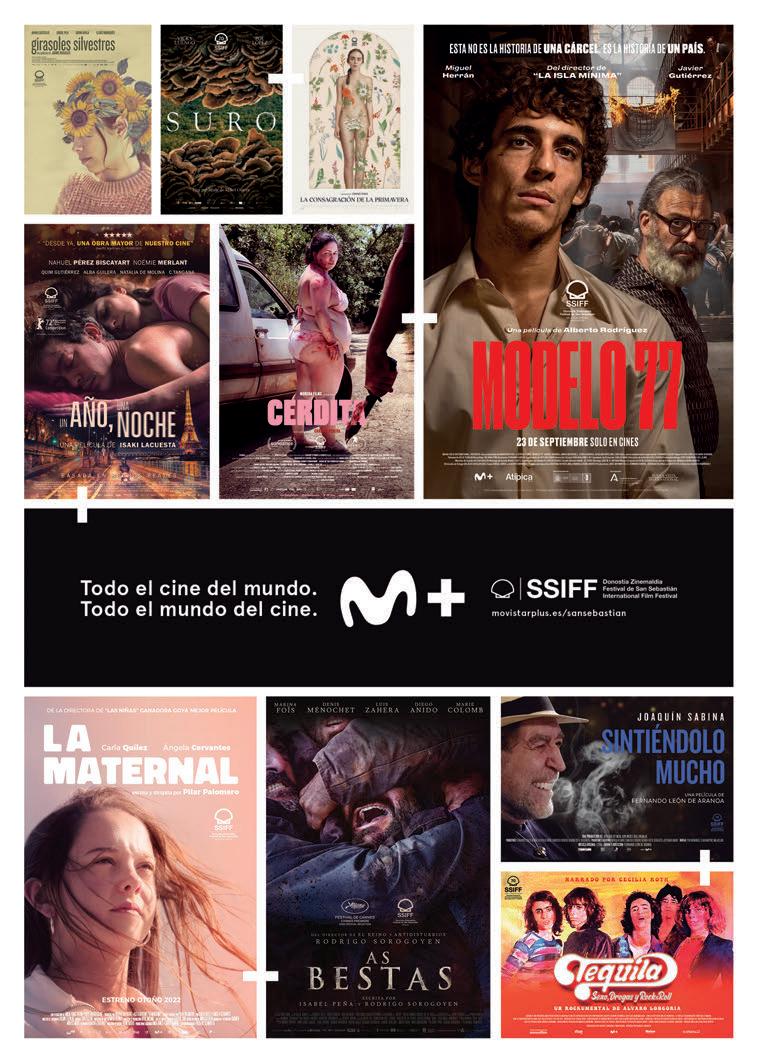
3 minute read
David Cronenberg
from Donostia Cine 2022
by editorialmic
David Cronenbergek (Toronto, Kanada, 1943) gaixotasuna, indarkeria, sexua, gorputza, esperimentazio zientifikoa eta halako gaien inguruan eratu du bere filmografia; izan ere, esperimentazio zientifikoak oso presentzia handia du Shivers (1975), Rabid (1977) eta The Brood (1979) filmetan.
Scanners (1981) eta Videodrome (1983, Haragi Berria deritzonaren estetikaren gailurretako bat) filmek finkatu zuten Cronenbergen ospea. The Fly (1986) lanean intsektu bihurtzen den zientzialari baten istorioa kontatu zigun; horren ondoren, ginekologo biki biren rola egin zuen Jeremy Ironsenek Dead Ringers (1988)
Advertisement
Cronenbergen filmean, eta operako diva batez maitemintzen den diplomatiko batena, berriz, M. Butterfly (1993) pelikulan.
Idazleen liburuak ere egokitu izan ditu: Stephen King (The Dead Zone, 1983), William Borroughs (Naked Lunch, 1991) eta J. G. Ballard (Crash, Epaimahaiaren Sari Berezia Cannesen, 1996), adibidez.
Bestalde, eXistenZ (1999) pelikulan errealitate birtuala jorratu zuen eta Spider (2002) filmean, berriz, gaixotasun mentala. Ondoren, Viggo Mortensen presentzia izan zuen A History of Violence (2005) eta Eastern Promises (Sail Ofiziala, 2007) thrillerretarako, eta A Dangerous Method (2011) lanetarako. Geroago, Cosmopolis (2012) eta Maps to the Stars (2014) etorri ziren, eta Julianne Moorek emakumezko aktore onenaren saria irabazi zuen Cannesen lan horrekin. Nightbreed (1990, Clive Barker), To Die For (1995, Gus Van Sant) eta Falling (Viggo Mortensen, Donostia Sari Bereziaren emanaldia, 2020) filmetan parte hartu du aktore gisa.
Cannesen estreinatutako Crimes of the Future filma Donostia Saria entregatzeko galaren ondoren emango da.
David Cronenberg (Toronto, Canadá, 1943) ha construido su filmografía sobre temas como la enfermedad, la violencia, el sexo, el cuerpo o la experimentación científica, esta última muy presente en Shivers (Vinieron de dentro de…, 1975), Rabid (Rabia, 1977) y The Brood (Cromosoma 3, 1979).
Los títulos que forjaron su prestigio fueron Scanners (1981) y Videodrome (1983), una de las cimas de la estética de la Nueva Carne. Tras narrar en The Fly (La mosca, 1986) la transformación en insecto de un científico, contó con Jeremy Irons para encarnar a dos gemelos ginecólogos en Dead Ringers (Inseparables, 1988) y a un diplomático enamorado de una diva de ópera en M. Butterfly (1993).
Ha adaptado a escritores como Stephen King (The Dead Zone / La zona muerta, 1983), William Borroughs (Naked Lunch / El almuerzo desnudo, 1991) o J.G. Ballard (Crash, Premio Especial del Jurado en Cannes, 1996). Abordó en eXistenZ (1999) la realidad virtual y en Spider (2002) la enfermedad mental, y después contó con Viggo Mortensen para los thrillers A History of Violence (Una historia de violencia, 2005) y Eastern Promises (Promesas del Este, Sección Oficial, 2007), y para A Dangerous Method (Un método peligroso, 2011). Les siguieron Cosmopolis (2012), y Maps to the Stars (2014), por la que Julianne Moore ganó el premio a la mejor actriz en Cannes.
Ha intervenido como actor en películas como Nightbreed (Razas de noche, 1990, Clive Barker, To Die For (Todo por un sueño, 1995, Gus Van Sant) o Falling (Viggo Mortensen, Proyección Especial Premio Donostia, 2020).
Crimes of the Future, la película con la que compitió en el último Festival de Cannes, se proyectará tras la gala de entrega del Premio Donostia.
David Cronenberg (Toronto, Canada, 1943) has built his body of work around subjects including disease, violence, sex, the body and scientific experiments, the last of which was strongly present in Shivers (1975), Rabid (1977) and The Brood (1979).
The titles that forged his prestige were Scanners (1981) and Videodrome (1983), one of the peaks of the New Flesh aesthetics. Having told the tale of a scientist’s transformation into an insect in The Fly (1986), he worked with Jeremy Irons in the role of two gynaecological twins in Dead Ringers (1988) and as a diplomat enamoured with an opera diva in M. Butterfly (1993). He has adapted authors such as Stephen King (The Dead Zone, 1983), William Borroughs (Naked Lunch, 1991) and J.G. Ballard (Crash, Special Jury Prize at Cannes, 1996).
He looked at virtual reality in eXistenZ (1999) and mental illness in Spider (2002), going on to work with Viggo Mortensen on the thrillers A History of Violence (2005) and Eastern Promises (Official Selection, 2007), and on A Dangerous Method (2011). These were followed by Cosmopolis (2012) and Maps to the Stars (2014), for which Julianne Moore won the Best Actress Award in Cannes.
As an actor he has performed in films including Nightbreed (Clive Barker, 1990), To Die For (Gus Van Sant, 1995) and Falling (Viggo Mortensen, Donostia Award Special Screening, 2020). He has recently competed at Festival de Cannes with Crimes of the Future, which will screen following the Donostia Award presentation gala.









